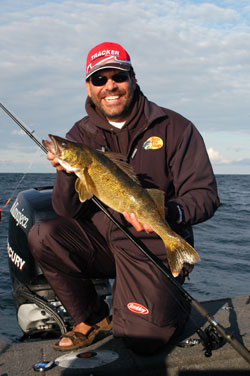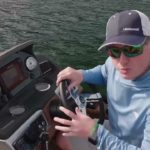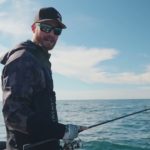Details of the Game “¦The Right Connections Can Make All the Difference
 Most of you have experienced it at one time or another. You are in the right spot at the right time but it seems the guy in the boat next to you (or even in the same boat as you) is whacking the walleyes while your offerings go untouched. You’re on the same structure, using the same basic presentation, but you aren’t catching the fish he is. What’s the key? What is he doing different? Chances are he’s doing very little different. But that “very little” is obviously making a big difference. It’s an old cliché but a valid one … the things that separate a good angler from a great one are the little things … the details.
Most of you have experienced it at one time or another. You are in the right spot at the right time but it seems the guy in the boat next to you (or even in the same boat as you) is whacking the walleyes while your offerings go untouched. You’re on the same structure, using the same basic presentation, but you aren’t catching the fish he is. What’s the key? What is he doing different? Chances are he’s doing very little different. But that “very little” is obviously making a big difference. It’s an old cliché but a valid one … the things that separate a good angler from a great one are the little things … the details.
The range of details that matter can be vast, and covers all aspects of the game. It may be a tweak in your boat control, or as simple as the color of your hook. And it doesn’t only pertain to walleye fishing. No matter what species of fish you primarily target, there are always details that you can implement to help yourself be more productive on the water.
To be honest, I never really gave much thought to exactly what kind of details made a big difference in my fishing. That is until I began to think about all the questions I’m asked by other fishermen. Whether I’m at seminars, tournaments or visiting the Forum pages of our website, I’ll bet at least ninety percent of the questions deal with “little stuff”, or those minute details that I may have actually taken for granted as common practice.
One category of “details” that seems to spawn a great deal of confusion are the knots and other connections we as anglers use in our various presentations. Most anglers already know the basic knots like the Improved Clinch and Palomar Knot for connecting line to lures. It’s important to keep a couple things in mind even with these basic knots. When tying an Improved Clinch Knot with a braided line or something like Berkley FireLine, make sure you add a couple more wraps to the knot. These lines tend to be more “slippery” than conventional lines, and the extra wraps help them hold better. When tying any knot with fluorocarbon line, its important to wet the line really well before pulling the knot tight. Fluorocarbon line tends to build up friction more than conventional lines, and can actually damage itself at the knot if not properly lubricated.
Most questions I hear regarding “connections” however have to do more with the knots that one might consider the “terminal tackle” sort of knots. For instance, a very often asked question is “What knot is best for connecting braided line to monofilament?” Whether its for the purpose of connecting your braided line to a backing on the reel spool, or in the rare case that one might wish to connect a leader to their braided line (something I don’t personally do, but some anglers prefer to), the Double Uni Knot is both easy and strong. Designed to connect two lines of similar diameter, the double Uni Knot slides through guides easily and lays well on the spool.
There also seems to be a lot of questions from anglers looking to tie their own two hook crawler harnesses, wanting to know what the best knot is for snelling hooks. Well I’m not sure what the strongest snell knot is but I do know what I believe to be the easiest one to tie is and it has served me well for many years. It’s called the Quick Wrap, and I like it because it allows me to place the hooks precisely on the line, at a distance I like for hooking crawlers.
 The procedure I use to tie a Quick Wrap goes something like this:
The procedure I use to tie a Quick Wrap goes something like this:
1.Put your snell line "up" through the eyelet of the hook and position the hook on the line – I normally put the bottom of the "nose" hook 3&1/2 inches from the top of the "bottom" hook.
2.Wrap the loose end of the snell line 8 times around the shank of the hook starting from the eye working down to the gap of the hook – do not overlap wraps
3.Now take the loose end and put it up through the eyelet of the hook – that’s it.
As for what line to use for tying crawler harnesses, I suggest Berkley Vanish fifteen pond test Leader Material (not the regular Vanish fishing line). The leader material is a bit stiffer than the fishing line, and I have never had a walleye break me off yet (or have the snell knot come loose) …. Knock on wood!
I also get a lot of anglers wanting to know what the best way is to connect a leader to lead core line. I know I used to use a knot system for doing this, but found it made changing leaders cumbersome and wasn’t always reliable.
I have since switched to using size #18 swivels mainly so that I can quickly change leaders if I need to. To tie the lead core to the swivel, pull the Dacron outer sheath down off the lead core center about 4 inches. Break out the lead and throw it away. Next tie the Dacron (with no leader) to the swivel using an Improved Clinch knot. Now you can tie a mono or fluorocarbon leader (using a standard Improved Clinch) or a FireLine leader (with an improved clinch with 8 wraps) to the swivel. You will need to have a reel that has a wide enough line guide to allow the swivel to pass into the reel. I use the Bass Pro Shops Gold Cup Line Counter Reel, model GC4000LBC. It not only has a plenty large enough line guide, but also the line capacity needed for lead core.
One other connection that I seem to get questioned about quite often has to do with jigs. It seems some anglers are unsure about whether a jig should be tied to directly, or whether a snap or even a snap swivel should be used between the line and the lure.
While it’s true, using a snap to connect a jig would make it easy to switch jigs in order to experiment with size and/or color, and a snap swivel would help eliminate line twist that occasionally occurs, I would never connect a jig by any means other than tying the line directly to the jig. All that extra hardware is unnecessary and could actually take away from the bait’s appeal. Jigging is a game of “feel”. That’s why I think the most direct connection you can have to the jig the better. A sensitive rod and no-stretch line tied directly to the jig will allow you to feel that jig hit the bottom, bump the cover and detect bites instantly. No need to make it more complicated than that.
That’s just a drop-in-the-bucket when it comes to the details that can make you a more productive angler. And believe me, the more you get into this sport, the more questions you’re likely to have about what details make a difference in different situations.
That’s why utilizing website forums like you’ll find on The Next Bite (www.thenextbite.tv), joining a fishing club and attending seminars can be so much help. These give you direct contact with other anglers that you can learn from. It’s all a matter of asking the questions and listening to the answers. That, and your own trial and error will teach you the finer points of angling. Oh yeah … reading the right magazines can make a big difference too!





